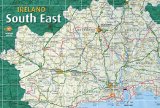South East Ireland Tourism
Travel guide to Ireland's south east
Travel guide to Ireland's south east
Dungarvan Town, Waterford
Dungarvan is the administrative capital for County Waterford. It is a bustling market town in a high tourist amenity area. Although there is some dispute about monastic and early Viking settlement in the Dungarvan area, the town owes its foundation to the Anglo-Normans in the 12th century. Their motte and bailey at Gallows Hill to the west of the town still survives. A charter was granted by King John in 1215 and the town prospered until it was destroyed in 1582, after which it declined. Because of its strategic location, Dungarvan was the focus for many 17th century battles. It never regained its medieval prosperity as it lacked the amenities of a good trading port. The Duke of Devonshire engaged in a programme of rebuilding at the turn of the 19th century and Dungarvan today owes much of its shape to that period. Relative prosperity returned, but was short lived, as the great famine of the 1840s had a devastating effect.
Despite some further setbacks Dungarvan today is a thriving commercial and tourist town and is an ideal centre for touring the Comeragh Mountains and the Ring Peninsula.
The Market House, in Parnell Street, renamed the Old Market House Arts Centre for its exhibition space for local, national and international artists dates from the 17th century. The Dungarvan Museum, situated in the Old Town Hall on St Augustine Street, presents the history of Dungarvan and West Waterford through a series of displays and panels.
Head towards the harbour and Barrack Lane where St. Garvan’s Church is situated. This was thought to be the site of a 16th century church dedicated to St. Garvan, who is reputed to have established the first settlement here.
Across from St. Garvan’s is Dungarvan Castle, a 12th century Anglo-Norman castle. It was the focus of many of the battles visited on the town.
Davitt’s Quay (above), constructed in the early 19th century has now undergone many changes, the most recent being the redevelopment of a number of derelict stores and warehouses along the quayside into a modern, cosmopolitan residential and commercial centre.
Golf enthusiasts can avail of the many scenic Golf Clubs in the area: West Waterford, Dungarvan and Gold Coast.
For more adventurous pursuits, Road Karting at Millstreet, Cappagh can offer a challenge, and Water sports enthusiasts can discover a unique and wonderful way of exploring the Dungarvan Coastline by Sea Kayak.
Dungarvan is also an ideal base from which to tour the Ring and Ardmore peninsula, the Blackwater Valley, the Comeragh and Nire Valley Drives, the Vee Scenic Drive via Lismore and, of course, the Coastal Drive to Tramore. (Coastal Drive brochures are available from the Dungarvan Tourist Office.)
Dungarvan is a noted deep sea angling centre, with shark, general ground and wreck fishing available. General angling is from April to October with shore fishing extending to January. Check our Angling Section.
If planning a visit to Dungarvan, why not plan around the Dungarvan Jazz Festival which takes place every February. Another important event which takes place in Dungarvan around May each year is the famous traditional music festival Feile na nDeise.
<< Return to Waterford page
Despite some further setbacks Dungarvan today is a thriving commercial and tourist town and is an ideal centre for touring the Comeragh Mountains and the Ring Peninsula.
Things To Do
St Mary’s Church (Church of Ireland), entrance through a gate on Emmet Street, was built in 1828 by George Richard Pain. The stark gable wall standing to the back of the church is thought to have formed part of the pre-Reformation church of St. Mary the Virgin. The Churchyard contains some interesting gravestones. On the west side of the cemetery is a mass grave and a memorial to those who died in the Moresby shipwreck in 1895.The Market House, in Parnell Street, renamed the Old Market House Arts Centre for its exhibition space for local, national and international artists dates from the 17th century. The Dungarvan Museum, situated in the Old Town Hall on St Augustine Street, presents the history of Dungarvan and West Waterford through a series of displays and panels.
Head towards the harbour and Barrack Lane where St. Garvan’s Church is situated. This was thought to be the site of a 16th century church dedicated to St. Garvan, who is reputed to have established the first settlement here.
Across from St. Garvan’s is Dungarvan Castle, a 12th century Anglo-Norman castle. It was the focus of many of the battles visited on the town.
Davitt’s Quay (above), constructed in the early 19th century has now undergone many changes, the most recent being the redevelopment of a number of derelict stores and warehouses along the quayside into a modern, cosmopolitan residential and commercial centre.
Golf enthusiasts can avail of the many scenic Golf Clubs in the area: West Waterford, Dungarvan and Gold Coast.
For more adventurous pursuits, Road Karting at Millstreet, Cappagh can offer a challenge, and Water sports enthusiasts can discover a unique and wonderful way of exploring the Dungarvan Coastline by Sea Kayak.
Dungarvan is also an ideal base from which to tour the Ring and Ardmore peninsula, the Blackwater Valley, the Comeragh and Nire Valley Drives, the Vee Scenic Drive via Lismore and, of course, the Coastal Drive to Tramore. (Coastal Drive brochures are available from the Dungarvan Tourist Office.)
Dungarvan is a noted deep sea angling centre, with shark, general ground and wreck fishing available. General angling is from April to October with shore fishing extending to January. Check our Angling Section.
If planning a visit to Dungarvan, why not plan around the Dungarvan Jazz Festival which takes place every February. Another important event which takes place in Dungarvan around May each year is the famous traditional music festival Feile na nDeise.
Dungavan Map
<< Return to Waterford page






